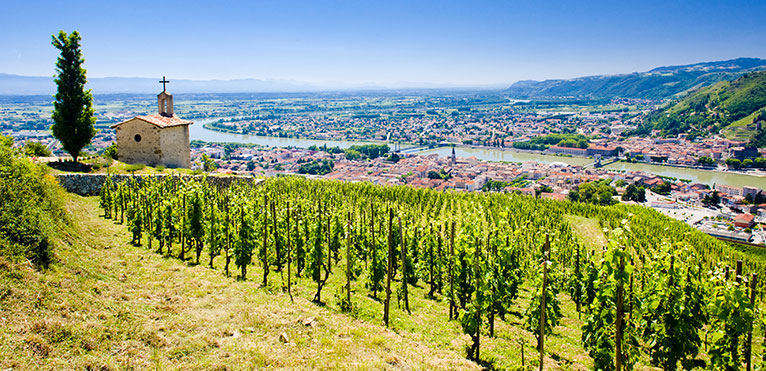
Contents
Ventoux is a wine appellation in the Rhône Valley. It is located to the south-east of the valley. This appellation produces 56% red wines, 38% rosé wines and 6% white wines. The vineyard has held the French AOC Côtes-Du-Ventoux label since 1973, becoming AOC Ventoux on November 30, 2008.
Ventoux, a wine of God’s grace
The specificity of Ventoux wines is closely linked to their location. In fact, the vineyard is located up close of Mont Ventoux. The Mont Ventoux region is a protected area where vines are grown in a way that protects the environment and the region’s cultural heritage. All these measures have enabled the vineyard to acquire the status of a natural site classified as a “biosphere reserve” by UNESCO.
The region’s viticultural origins date back to antiquity, when vines were already growing here. It was here, for example, that France’s first wine amphorae were found during excavations, dating back to the 1st century BC. It was mainly the priests of Avignon and the monks of Montmajour Abbey who worked to develop the cultivation of vines in the area. Subsequently, families of notoriety kept the vineyards alive and helped the appellation earn its letters of nobility.
Ventoux vineyards with rich soils
The Ventoux vineyards are located in the southern Côtes du Rhône, close to other wine appellations such as Beaumes-de-Venise, Vacqueyras and Gigondas. Its southern position in the Rhône Valley means it enjoys a temperate Mediterranean climate with plenty of sunshine, all topped by the Mistral wind. The total vineyard area is 6,700 hectares.
The soil of the vineyard is mainly composed of marine deposits, and limestone rocks at the base of Mont Ventoux. Three different types of soil can be observed in the region: red soils due to the decay of limestone, soils made of clay and sand, and gravel soils from the mountains.
Ventoux is a floral and fruity wine
Ventoux reds and rosés are made from several grape varieties, the main ones being Grenache noir, Syrah, Cinsault, Mourvèdre and Carignan. Secondary grape varieties such as Picpoul noir and Counoise may be used up to a limit of 20%.
To the eye, Ventoux red is a brilliant ruby color. On the nose, it has aromas of red fruit and spices, with hints of licorice and wood. You can even smell truffles or leather. The red will be long on the palate, supple and rich in aroma. It can be kept for 5 to 10 years.
The rosé has a very pale pink to light ruby color, with floral accents complementing the nuances of cherry and raspberry. On the palate, red fruit aromas dominate and persist. It doesn’t keep very well, with a shelf life of 1 to 3 years.
The white Ventoux, meanwhile, is made from entirely different grape varieties, such as Bourboulenc, Clairette, Grenache blanc and Roussanne. Secondary grape varieties such as Ugni blanc, Picpoul and Pascal blanc may be added to the blend. . This will give her a dress very clear and sparkling with yellow-green highlights. On the nose, you’ll detect floral (narcissus, iris, acacia) and fruity (pear, green apple, almond, citrus) notes. On the palate, floral and fruity aromas dominate. Like rosé, it doesn’t keep very long: between 1 and 3 years.
Ventoux is a well-balanced wine
Ventoux wines are very fruity, allowing them to reign with a perfect balance of freshness and elegance.
Ventoux reds go very well with sun-dried tomato and olive cake, or red meats and small game. It goes very well with cheeses such as Saint-Félicien. Its ideal drinking temperature is around 16°C.
Rosé goes perfectly with Asian dishes, charcuterie and poultry. Ventoux rosés are one of those rosés where the new trend is to drink them throughout the meal. Best served between 8 and 10°C.
Finally, Blanc de Ventoux goes very well with skate terrine, or more generally as an aperitif, with grilled fish or seafood. The ideal drinking temperature is 9-10°C.
Numerous vintages for AOC Ventoux
For red wine, the crus du siècle were produced in 1978, 1989, 1990 and 2000.
For white wine, the vintages of the century are 1989 and 1998, because they were particularly exceptional vintages. 1978 is even referred to as the vintage of the millennium.
Traditional Ventoux estates
Domaine De Piéblanc
Domaine de Piéblanc is quite young, having been conceived in 2014 by Matthieu Ponson, an engineer with a passion for wine. Its aim is to produce wines that are emblematic of the region. The entire estate is farmed in the traditional way, and the grapes are harvested and sorted by hand.
Domaine de Chêne-Bleu
The Chêne Bleu vineyard is located at the foot of Mont Ventoux, in La Verrière, a former medieval residence now transformed into a bed & breakfast. The estate offers a range of wine tourism activities (tastings, workshops, guided tours, lunches, etc.). All our wines are crafted with authenticity and respect. In fact, the vineyard is undergoing organic conversion and is a test site for biodynamic viticulture.
Discover the best Ventoux winemakers.